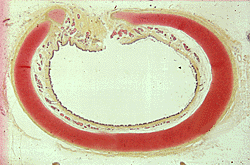 CORE TOPIC:
CORE TOPIC: CORE TOPIC:
CORE TOPIC:
Trachea (LP) The trachea is a rigid tube about 10 cm long. Embedded within the wall are between 16 and 20 C-shaped hyaline cartilages which maintain the patency of the airway. This is a section through one of the tracheal cartilages (stains pink). The trachea is the most anterior structure in the neck. The open ends of the cartilage would be in direct contact with the oesophagus. A bundle of smooth muscle fibres, the trachealis muscle, completes the circumference of the trachea. Trachealis muscle contracts during coughing reducing the diameter of the trachea and increasing the velocity of the air in forced expiration.
The conducting passages, including the trachea, are lined by respiratory epithelium.
| Core | Supplementary Material on Trachea | ||
| Previous Topic Next Topic | trachea (MP) | trachea LS (MP ) | tracheal epithelium (HP) | Return to Respiratory System Main Index |